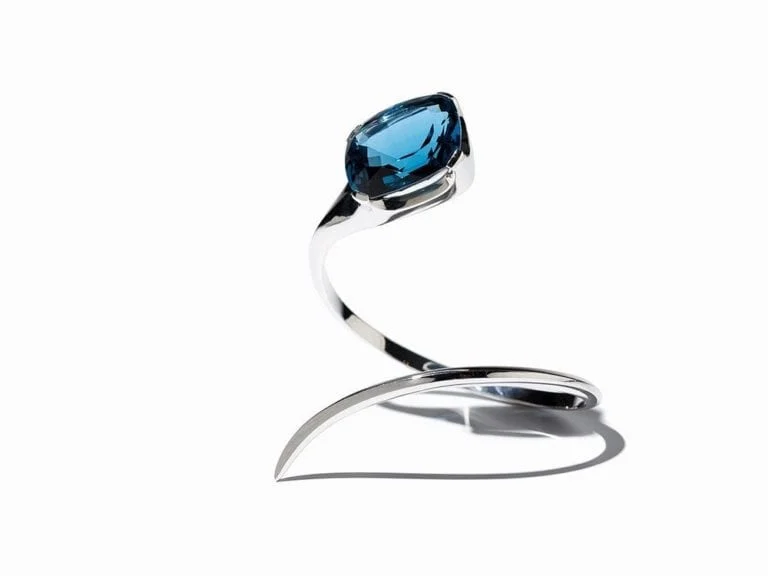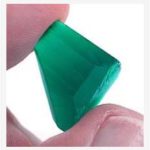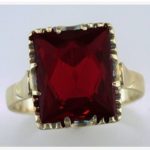What’s the Difference Between Synthetic, Simulated, and Created Gemstones?
 Synthetic Gemstones: Some people make distinctions between different kinds of synthetic or lab-grown gems. In fact, you may even find different definitions of synthetic material. Two other terms commonly used in jewelry are simulated and created gemstones. To clarify matters, here are some general definitions of these words.
Synthetic Gemstones: Some people make distinctions between different kinds of synthetic or lab-grown gems. In fact, you may even find different definitions of synthetic material. Two other terms commonly used in jewelry are simulated and created gemstones. To clarify matters, here are some general definitions of these words.
 You’ll hear many terms used interchangeably with synthetic, such as “artificial,” “lab-grown,” “lab-made,” “man-made,” etc. All these terms identify gemstones created in laboratories, not in nature.
You’ll hear many terms used interchangeably with synthetic, such as “artificial,” “lab-grown,” “lab-made,” “man-made,” etc. All these terms identify gemstones created in laboratories, not in nature.
There are many processes for synthesizing gems. Some are inexpensive, some are very expensive, but they’re all conducted artificially, in a lab. They may mimic or reproduce natural processes and use the same ingredients found in the natural stones. However, these processes occur in labs, not underground in nature.
Some synthetic stones are chemically and optically identical to their natural counterparts. For example, synthetic emeralds may be real emeralds but not natural emeralds.
Depending on the process used, synthetic gemstones may even have the same inclusions and flaws found in natural gems. Or, they may have telltale signs they’re synthetic. Distinguishing between synthetics and their natural counterparts can be very difficult.
However, some synthetic stones just look like natural stones without being chemically and optically identical to them. (Some synthetic stones have no counterparts at all in nature). Gemstones synthesized in a lab that simply imitate natural stones are called simulated gemstones or simulants.
 Simulated Gemstones: Not all simulants originate in labs. Glass pieces and assembled stones like doublets and triplets are often used to simulate natural gems. Sometimes, vendors may present one kind of natural gemstone as another, for example, a garnet doublet cut to look like a ruby. Jewelers also frequently use spinels, both natural and synthetic, to imitate other gemstones.
Simulated Gemstones: Not all simulants originate in labs. Glass pieces and assembled stones like doublets and triplets are often used to simulate natural gems. Sometimes, vendors may present one kind of natural gemstone as another, for example, a garnet doublet cut to look like a ruby. Jewelers also frequently use spinels, both natural and synthetic, to imitate other gemstones.
Regardless of its origins, a simulated gemstone is a piece presented to “look like” another gemstone. A close gemological analysis would reveal its true identity. Simulants are also called imitations, faux, and fakes. While a garnet simulating a ruby may be a real garnet, it’s a fake ruby. Some vendors may be honest about selling simulants. Others may not disclose what the gem truly is. (Sometimes, gems are sold with misleading names). Buyer beware.

Created Gemstones: People who sell synthetic gems rarely use the word “synthetic.” You’ll almost always find “created gemstones” instead of synthetic gemstones for sale. Although a synthetic may be a real gemstone, the term “synthetic” has strong popular connotations of being “not real” as well as “not natural.”
Gemologically, a synthetic stone may be both real and not natural. Nevertheless, some consumers may find this qualification hard to accept. Referring to synthetic as created gemstones may help skirt those associations altogether.
Synthetic or created gemstones have been on the market since the early 1900s. Simulated gemstones or “lookalikes” have been around as long as people have valued gems. Don’t assume that an old stone is a natural stone.
 Treated Natural Gemstones: There are many gemstone treatments and enhancements used to improve natural gemstone rough. For example, heat is often used on sapphire to improve color and melt silk inclusions. Some people would consider all treated stones as synthetic or created gemstones. Personally, I don’t generally agree with this view. However, I think a gray area does exist. If a natural gem receives extreme treatments, it should fall under the synthetic category.
Treated Natural Gemstones: There are many gemstone treatments and enhancements used to improve natural gemstone rough. For example, heat is often used on sapphire to improve color and melt silk inclusions. Some people would consider all treated stones as synthetic or created gemstones. Personally, I don’t generally agree with this view. However, I think a gray area does exist. If a natural gem receives extreme treatments, it should fall under the synthetic category.